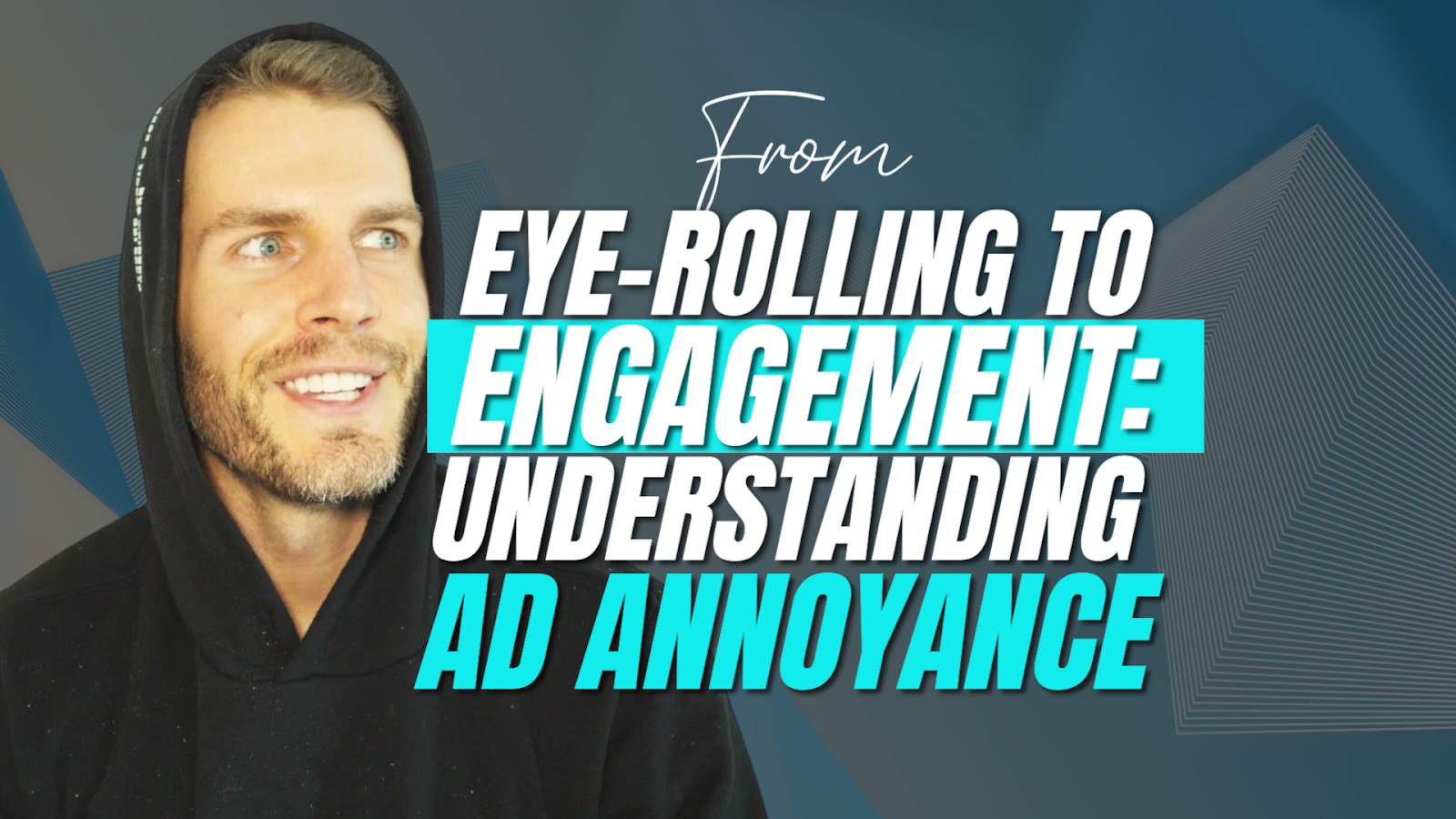
From Eye-Rolling to Engagement: Understanding Ad Annoyance
Have you ever wondered why some ads make us roll our eyes while others engage us? In the digital age, understanding ad annoyance is critical to the success of any business looking to stay ahead in the advertising industry. Ads can be an excellent tool for connecting with potential customers, spreading awareness about products and services, and driving sales.
Unfortunately, not all ads are created equal. Ads can easily cross the line from effective to annoying, leading to low engagement and potential customers turning away from your product or service.
Ad annoyance is any unpleasant feeling experienced when viewing an ad, whether it be a feeling of frustration, irritation, or boredom. It can lead to consumers not engaging with brands, ultimately hurting your bottom line.
However, understanding ad annoyance and taking steps to prevent it will help ensure your ads are optimized for engagement. In this article, we’ll explore what causes ad annoyance, its impact on businesses, strategies to prevent it, and best practices for crafting effective digital ad strategies. So let’s dive in!
What Causes Ad Annoyance?
A variety of factors can cause annoyance. Here are the primary causes:
Intrusive Ads

Ads that appear unexpectedly or interrupt the user experience can be extremely annoying and turn potential customers away from your product or service. Examples of intrusive ads include pop-ups, auto-played videos, and interstitial ads. These types of ads can be incredibly disruptive and take up valuable time and attention.
Misleading Ads
Misleading or deceptive advertising is also highly annoying and can damage a company’s reputation. Ads that are unclear about what they are promoting or contain false information can make customers feel betrayed and not want to purchase the product or service.
If an ad makes exaggerated claims or promises something too good to be true, a person is likely to feel misled and annoyed by the advertisement.
Repetitive Ads
Seeing the same ad repeatedly can lead to feelings of annoyance due to its familiarity. When people are exposed to the same ad multiple times, they may become desensitized and no longer receptive to its message. Persistent banners that follow people from page to page can also be irritating and off-putting.
The Impact of Ad Annoyance
Companies that fail to address ad annoyance risk losing potential customers and negatively impacting their business. Specifically, ad annoyance can have devastating effects on the following three areas:
Decreased Engagement
When ads are seen as annoying, potential customers are less likely to engage with them or take the desired action. This leads to decreased click-through and conversion rates and, ultimately, sales.
Diminished Brand Perception
Your brand is what people think of when they hear your name, and ad annoyance can diminish the perception of your brand. Here are some ways this can occur :
- People exposed to your ads may come away with negative impressions if they find them intrusive, deceptive, or repetitive.
- Annoying ads can create a disconnect between the user and the brand by alienating potential customers who would otherwise be interested in purchasing products or services.
- Ads that are not tailored to the user’s interests can lead to annoyance and an overall lack of trust in the brand.
- Poor targeted and irrelevant ads can confuse customers, damaging a company’s reputation.
Lost Revenue
The ultimate result of ad annoyance is lost revenue. When ads are seen as intrusive, deceptive, or repetitive, customers may choose to avoid the product or service being offered. This means that potential customers are no longer converted into paying customers, decreasing sales and revenue.

Additionally, poorly targeted or irrelevant ads can be a waste of money, as they create a disconnect between the user and brand without driving conversions. You can spend money on ads that are not seen by the right people or that are seen but do not create any meaningful engagement.
Strategies to Prevent Ad Annoyance
To prevent ad annoyance and ensure that your digital advertising campaigns are effective, it’s essential to implement strategies that will reduce the impact of intrusive or misleading ads. Here are a few key strategies to help you achieve this:
Targeted Advertising
By targeting ads to specific demographics and user interests, companies can ensure they reach the right people. Many platforms allow you to narrow your target audience by location, age, gender, and other filters. This helps to ensure that ads are tailored to the right people and are more likely to be relevant and engaging.
Frequency Capping
Limiting the exposure of the same ad through frequency capping will help reduce ad annoyance. Frequency capping is a strategy that limits the number of times an ad can be shown to the same user within a certain period. It ensures that people are not overwhelmed by the same ad repeatedly, which can lead to fatigue and desensitization.
Set a reasonable frequency cap that ensures people are still exposed to the ad enough times for them to take action, but not to the point where it becomes annoying. This helps to ensure that users are still interested in engaging with the ads and that the ad is seen as relevant and valuable.
Native Advertising
Native advertising allows companies to create content that blends in with the media platform on which it is displayed. Companies can ensure their ads are more engaging and relevant to users by creating ads that look like part of the platform.
Here are tips for making native advertising effective:
- Make sure the content is timely and relevant: don’t just create content for the sake of it.
- Keep the design simple: don’t overcomplicate or make it too flashy.
- Combine: Combine native advertising with other channels to increase reach and engagement.
- Consider user experience: make sure the ad is easy to understand and makes sense in the context of the platform it is being displayed on.
Interactive Ads
You want your ads to be engaging and memorable, and interactive ads are a great way to accomplish this. Interactive ads are designed to engage users by allowing them to interact with the ad itself. This could be a quiz, game, or even a short video designed to capture the user’s attention.
The key here is ensuring the interaction is relevant and helpful for users. Don’t just create something fun to play around with but has no real purpose or meaning. Keep the interaction short and sweet — you don’t want to overwhelm users with too much information. Keep it simple so that users can quickly understand the concept and take action.
Personalized Advertising
The target audience for a digital ad can vastly differ from user to user, and this is where personalization comes in. Personalizing ads makes them reach the right people with the right message. Here are some tips on how to personalize your ads:
- Research your target audience: Understand who they are and their needs so you can tailor your ads accordingly.
- Use data to personalize: Use data and analytics to customize the ad’s message, creative, or placement based on user behavior.
- Test and refine: Test different ad versions to see which ones work best with each target audience and make changes accordingly.
Transparency
Companies need to be transparent about their ads, so consumers know what to expect and can trust the company. This includes ensuring that ads are clearly labeled as such and providing detailed information about the product or service being advertised.
Advertisers should be open to consumer feedback and suggestions to ensure that ads are engaging, relevant, and provide value. Transparency leads to greater consumer engagement with ads and higher conversion rates.
Leverage Ad Annoyance Prevention Strategies Maximum Engagement & Growth
By understanding ad annoyance, businesses take proactive steps to prevent it and ensure their digital ads are optimized for engagement. From targeted advertising to interactive ads, there are a variety of strategies businesses can use to ensure their ads are inspiring customers rather than annoying them.
Companies must also ensure that their ads are transparent and accurately represent their products and services to build trust with potential customers. With an effective ad annoyance prevention strategy, businesses can avoid lost revenue and negative brand perception while reaping the rewards of greater engagement and customer loyalty.
Finally, it’s essential that businesses regularly review their ad strategies to ensure they are staying up to date with best practices. With these tips, you’re ready to craft digital ad campaigns that engage and convert — taking your business to the next level.
Start leveraging these strategies today for maximum engagement and growth. Your success awaits!
